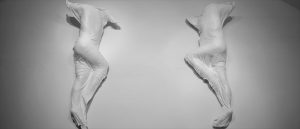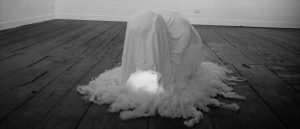Japanese artist naturalized Italian, Makoto (Maebashi) elaborates his poetic starting from suggestions raised by the human body which in its yield lightweight, strong and subtle at the same time, finds its full celebration. The elegance of the anthropomorphic figures now suspended, now lying on the floor, recalls the “classic” sculpture, whose charm subtly seduces. The encounter with the Western artistic heritage during the educational years at the Academy of Fine Arts in Carrara has, in fact, had a profound effect on the artist’s career, enriching his imagination and fueling the search for form as the center of his expression.

Makoto’s attention is focused primarily on plastics evidence, free from any chromatic vibration: a “White Code” which becomes an invitation to the perception of the non-objective. Free from the processing techniques of materials learnt in Carrara, since the nineties Makoto begins to perfect a personal process that involves the use of a plastered fabric lying on the human body, the “Veil of Veronica” that holds the energy of who wore it and that of the artist who has chosen and shaped the content, then returned in the form of nukegara, bare. A process that goes from the outside to the inside, and that is linked to the practice of Shiatsu to which Makoto dedicated intensely for several years. Before stretching the plastered fabric on the body of the model, the latter is subjected to a Shiatsu treatment, made by the same artist, that releases an energy then branched into the fibers of the fabric. The wire, the base material used by the “sculptor of fabric,” unites East and West in a emotional synthesis.

The visible form becomes the instrument through which Makoto transforms the absence in presence, it becomes the trace of a tangible reality reproducible only in the mind of the beholder. The “living” form refers to what form has not, to the dialectic between being and becoming noticeable in a given space. Refers to that vital energy that allows no distinction between object and subject, and in particular between work and observer. The choice of white, typical of Makoto, responds to this need: it contains within itself all the tones and shades of meaning that each viewer is free to assign to the work when perceived. Within the immobility of the form, a dynamic of relationships stay in a flux, in a perpetual “unfinished” that lives and vibrates here and now.

According to this dynamic, the space, far from being a mere container, is a key factor to the development of the works since their creative phase. The modus operandi provides, in fact, a preliminary phase during which the study of the architectural space suggests the shape of nukegara creating “site specific works”. Shapes presented in a three-dimensional covered body seen from the back, begin to “undress” in recent works: the totality of the body alternates the fragment caught in its seductive facade. Multifaceted and meditative artist, Makoto expressed his creativity devoted to various activities (acting and performing, the art of origami), using different media and collaborating with dancers, photographers, designers, musicians, filmmakers. The many national and international successes confirm the talent of a sensitive artist, able to look with equal acumen between East and West and protagonist of this Japanese Pavilion at the Universal Exhibition in Milan in 2015.
Giusy Marfia
